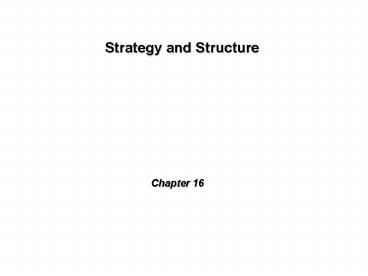Strategy and Structure - PowerPoint PPT Presentation
1 / 23
Title:
Strategy and Structure
Description:
Simple tasks performed by a small group people can be structured in a number of ways: ... Dyeing. Unnatural Grouping. Natural Grouping. Coordination and Control ... – PowerPoint PPT presentation
Number of Views:33
Avg rating:3.0/5.0
Title: Strategy and Structure
1
Strategy and Structure
Chapter 16
2
Introduction to Structure
Simple tasks performed by a small group people
can be structured in a number of ways
Individually members of the group are
compensated on the basis of individual actions
Self-managed teams member work together to set
and pursue common objectives, compensation is
partially based on team performance
Hierarchy of authority one member of the group
specializes in monitoring and coordinating the
work of others
3
Complex Hierarchies
Larger firms require complex hierarchies that
involve multiple groups and multiple levels of
groupings
Determination of appropriate groupings can be
difficult and involves to related problems
Departmentalization
Coordination of activities
4
Departmentalization
Departmentalization involves the division of an
organization into formal groupings.
Groupings may be defined along a number of
different dimensions
Tasks or functions
Inputs or outputs
Geography
Time or length of work
5
Departmentalization
Choices concerning departmentalization are not
independent of decisions concerning firm
boundaries
Important factors to consider in organizing
departments include
Economies of scale and scope
Transactions costs
Agency costs
Function and incentive structures
6
Unnatural Grouping
Natural Grouping
7
Coordination and Control
Coordination involves the flow of information to
facilitate sub-unit decisions that are consistent
with each other and with organizational objectives
Control involves the location of decision-making
and rule-making authority within the hierarchy
Coordination and control directly involve issues
concerning
Technical efficiency
Agency efficiency
8
Generic Approaches to Coordination and Authority
Autonomy or self-containment activities are
organized along product groups each of which
contain all basic business functions
Profit Centers
Responsibility Centers
Lateral Relations make sense when realizing
economies of scale or scope require coordination
among activities that cut across product groups
Centralization versus decentralization
9
Basic Types of Organizational Structures
There are four basic structures for large
organizations
Unitary functional structure U-form
Multidivisional Structure M-form
Matrix Structure
Network Structure
10
Unitary Functional Structure (U-Form)
The term unitary functional refers to the fact in
this structure each grouping is responsible for
each of the basic business functions
Components or groupings are called departments
Each department receives direction from the
central headquarters
Structure promotes performance within departments
Coordination across departments can be problematic
11
Sample Organization Chart of a U-Form Structure
12
Multidivisional Structure (M-Form)
The multidivisional structure organizes groups by
product line, related business units, geography
or customer type
Divisions are groupings of interrelated sub-units
It has been argued that M-form structures develop
in response to problems of inefficiency and
agency that arise in U-form structures as they
increase in size and complexity
This occurs because the M-form structure improves
the division of labor between strategic and
operational divisions
13
Sample Organizational Chart of the M-Form
Structure
14
Matrix Structure
With a matrix structure the firm is organized
along multiple dimensions simultaneously
Individuals working at the intersections of the
matrix report information to two hierarchies
The matrix structure is useful when economies of
scale or scope provide a compelling reason for
organizing along more than one dimension or
activity
15
Sample Organizational Chart for a Matrix Structure
16
Network Structure
In a network, the basic unit of design is the
worker rather than a specified job or task
Virtual Firms as networks
Workgroups in a network structure are often
organized into crosscutting teams on the basis
of tasks, geography or customer base
Relationships between workgroups are governed by
often changing implicit and explicit requirements
of common tasks rather than by formal lines of
authority
Network and information cost and access
17
Example of a Network Structure The Spider Web
Organization
18
Contingency Theory
The basis of contingency theory is that there is
no uniformly best structure for all firms in
all circumstances
Three factors are argued to affect the relative
efficiency of different organizational structures
Technology and task dependence
Information flows
The tension between differentiation and
integration
Organizational design is a successive grouping of
positions to coordinate activities and use shared
resources efficiently
19
Task Interdependence
Task interdependence is the extent to which two
or more positions depend upon each other to do
their own work
Three modes of task interdependence
Reciprocal interdependence exists when two or
more workers or groups depend on each other to
accomplish tasks
Sequential interdependence exists when the
results of one group depends on that of another
group, but not the converse
Pooled interdependence exists when two or more
groups are not directly dependent, but are
associated through their independent
contributions to the success of the organization
20
Information Flows
The argument here is that changes in structure
come about in response to changes in the amount,
complexity or speed of information processing
that is required for decisions to be made
Firms should internalize activities when
information flows from them are critical
21
Balancing Differentiation and Integration
Under this view organizations must balance the
benefits from creating specialized groupings,
differentiation and the need to integrate these
groups into the corporate whole.
Differentiation provides the benefits of
division of labor
But these benefits are only realized is when the
whole is greater than the sum of the individual
parts (integration)
22
Structure Follows Strategy
Chandler argues that changes in organizational
structure have been largely been driven by
changes in strategy, which in turn have were
caused by changes in external conditions faced by
the firm
Role of history and creation of modern business
organizations
M-form structures emerged in the 1920 in response
to the limitations of the U-form structures
23
Other Notions of Strategy and Structure
Strategy, Structure and Multinational Firms
Strategy, Structure, Knowledge and Capabilities
Structure as Routine and Heuristic

